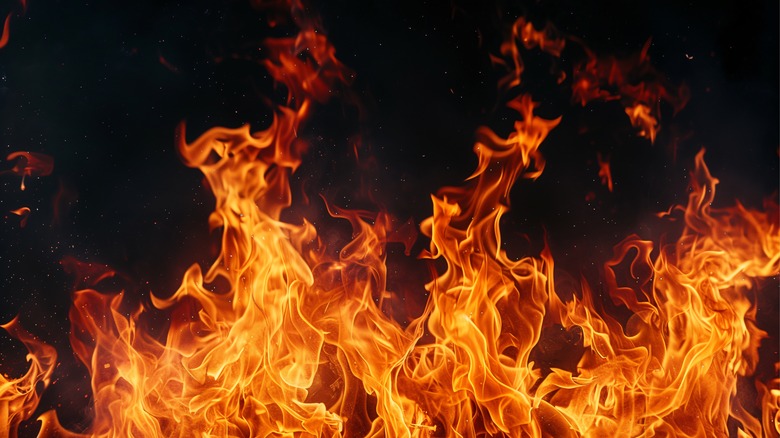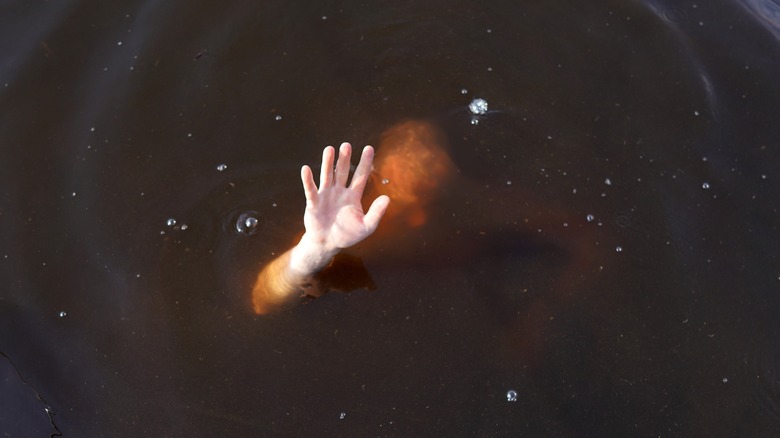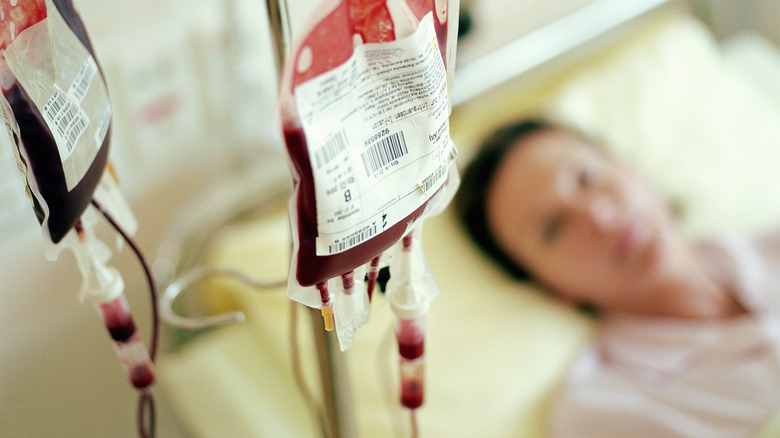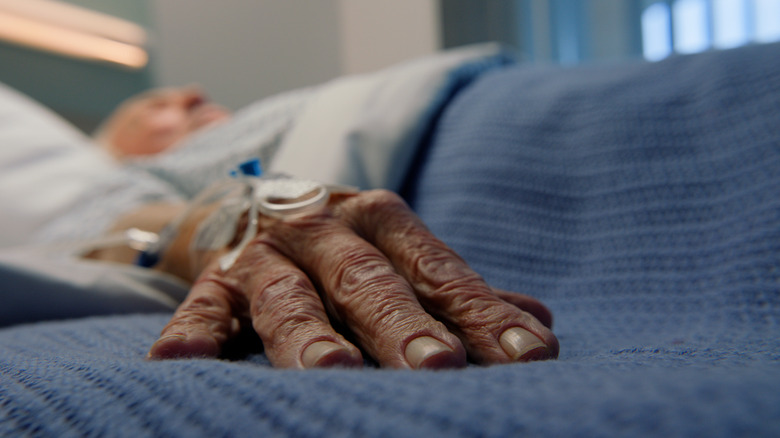What It Physically Feels Like To Die, According To Science
The following article features mentions of death and suicide.
It's probably safe to say that every religion, philosophy, and belief system has pondered the existence of death and its effect on things that live. Various scientific fields have been just as keen to find out everything they can about the great equalizer. Over the years, researchers have painstakingly catalogued all the stages of the human decomposition process, and even offered some mind-bending predictions about life after death.
However, such things tend to focus on what happens after death. For many people, the more immediate thing that comes to mind regarding death is considerably more pressing: What does death actually feel like?
Like most other scientific things, the answer to this question is far from simple. There are many different ways a human body can be damaged beyond repair, and all causes of death have their own effects on the body. To find out more about them, we'll take a look at some of the most common (and also some of the strangest) ways to die, and what science says they feel like.
Dying of thirst might not be very painful, but takes a long time
The lack of safe, abundant drinking water is an issue that affects over 2 billion people to some extent. However, the often-repeated "fact" that roughly 75% of American adults are dehydrated isn't really backed by science. (The real number is 28% at most, and based on reports about older adults.)
If a person has experienced the effects of dehydration, they'll likely remember the ordeal. Symptoms associated with a lack of proper fluid intake include fatigue, stiffness, headaches, and even scarier symptoms like fainting and seizures. Should the person be entirely deprived of water, they will die within days. When the body loses moisture, it can't regulate heat properly and the blood pressure will drop. Eventually, the body will start restricting blood flow to organs that aren't vital to immediate survival, which will ultimately damage organs enough to cause death.
There are certain, extremely particular circumstances when death by dehydration can be comparatively painless. In a 2017 article published in The Permanente Journal, Phillipa J. Malpas of the University of Auckland chronicled the final days of a terminally ill patient who'd chosen to stop all fluid intake as a form of euthanasia. The patient described the process as painless, but it took nine days, and dried her body to the point that speaking was soon impossible. However, others who have involuntarily experienced life-threatening dehydration describe it as a scary situation with an overwhelming sense of sickness and thirst, so it's far from a pleasant death.
If you or someone you know is struggling or in crisis, help is available. Call or text 988 or chat 988lifeline.org
Burning to death is extremely painful, until it isn't
Most people who die in building fires aren't actually killed by the fire itself, but from inhaling carbon monoxide, toxic fumes, and other assorted airborne components caused by the burning process. While all accidental deaths are tragic, this may be a consolation due to the sheer amount of agony associated with death by burning.
Burning to death is an incredibly painful experience. When fire touches a person's body, it first begins to destroy the outer epidermis layer of the skin, which is full of free nerve endings that are specifically meant to feel things. As such, the sensation is excruciating. Some five minutes later, the heat has shrank the underlying skin layer, dermis, enough for it to split open, which is when the truly unsavory developments begin. With the protective cover around the body severely compromised and the fire relentlessly burning up, the body's fat will start leaking out and muscles will contract. The person will eventually die from the trauma the fire causes — such as respiratory failure from smoke inhalation or lungs getting filled with fluids, organ failure, or simply from the body being burned beyond its ability to function.
The person will feel everything, but fortunately, it's only until the fire destroys the skin and the nerve endings. While this will happen fairly early in the process, the sheer amount of initial pain still makes burning to death one of the most awful ways to die.
Freezing to death is a complicated process
As anyone who's been out on a freezing day without sufficiently warm clothes knows, cold has a way of catching up with a person. However, actually freezing to death isn't as straightforward as one might think.
Freezing to death starts from the extremities — ears, nose, and the digits. Soon, other symptoms of hypothermia, such as trembling, speech issues, and unpleasant sensations creep in. Eventually, the cold will affect the body so much that a person's blood circulation will be disrupted and the brain can't emit signals properly anymore. As a result, the person starts losing their faculties, as well as the ability to feel pain. This stage often manifests as a counterintuitively serene feeling that effectively makes them give up. "A lot of people have given us a sort of experience when they were hypothermic and were eventually saved," neurologist Michael Kuiper summarized the situation to Deutche Welle. "They said they didn't want to go anymore, that they just wanted to sit on a bench in the snow. They were at peace ... they just didn't care about it anymore. When it starts, it is difficult, you feel unwell — you basically feel terrible. But when it gets worse, that pain goes away."
At a body temperature of around 85°F – just before death — a person may additionally experience a shocking sensation of warmth, which will cause them to start removing their clothes. This phenomenon is known as paradoxical undressing.
Death by beheading may not kill a person immediately
Beheading isn't what you'd call a common cause of death, but many people have lost their heads for various reasons across history. Much research on the subject of dying by beheading comes from the 18th and 19th century research and experiments by scientists who had the opportunity (and a sturdy enough stomach) to study people who were executed with the guillotine — the bladed decapitation instrument that surfaced as a popular method of execution in late 18th-century France. From their observations, they determined that while a clean beheading is thought to be a fairly easy and painless way to go, dying this way might not actually kill a person immediately. Instead, the head may live for some time after being separated from the body.
This will not be a lengthy period, though. Granted, some researchers who had the dubious honor of performing experiments on recently decapitated heads estimated that the head could remain alive and reactive for as long as 15 minutes. Research on rats later determined that a decapitated head will only retain brain activity for 10 to 15 seconds ... and that it had time to register the beheading as painful. Modern researchers think that while a decapitated human head may also be conscious for some time, it will die within seconds. Still, brief as it may be, the prospect of spending a few seconds in pain as a severed head sounds like a thoroughly harrowing experience.
Dying of starvation can take a very long time
Much like lack of water, food shortage is a global crisis. 319 million people live in acute hunger, and at the time of writing, 1.9 million people in Gaza, Sudan, and other places are in the throes of a catastrophic hunger situation. As such, dying from hunger is a very real and serious issue ... not to mention a truly horrifying way to go.
The time frame for dying of starvation depends on several factors, but it's a lengthy and deeply uncomfortable process — people on hunger strikes have been known to survive as long as 40 days. When a person is completely deprived of food, the body digs into its own energy reserves: first carbs and body fat, and eventually proteins. The body makes do with comparatively unimportant sources of nutrients as long as possible, but as supplying requisite nutrients to organs and muscles becomes impossible, organs and muscles start physically shrinking, which renders the person increasingly weak. Forced to make tough choices, the body eventually starts shutting down its most energy-consuming systems such as digestion, which leads to diarrhea. In a final bid to feed the organs, the body starts feeding on muscle tissue ... including the heart.
The body slowly feeding on itself and shutting down causes numerous organ issues that will eventually cause the person's death. The extreme hunger manifests as loss of focus and becoming irritable and apathetic.
Drowning is a harrowing, multi-stage process
The ocean can be horrifying, and it doesn't necessarily have anything to do with the many strange deep sea creatures science has discovered or our knowledge of the various prehistoric animals that are pure nightmare fuel. There's no point in fearing the things that hide in the water when the real threat is often the water itself.
Death by drowning is a grim process that starts with a person in water, struggling to stay afloat and keep water away from the respiratory system. The exact circumstances of this situation, which is known as swim failure, vary heavily and may not be present at all if the person is already submerged when the process begins. After the person can't tread water anymore and submerges, they attempt to hold their breath as long as they can, which is painful to the lungs. Eventually, they have to breathe in and possibly also swallow water. Unlike the previous stages — which are scary, exhausting, and painful — many survivors of nearly fatal drowning have reported that after water filled their lungs, they entered a peaceful, calm, and painless state. Shortly after this, the person becomes unconscious and the lack of oxygen will soon render them beyond saving.
Interestingly, water doesn't actually enter the lungs in an estimated 10% of drownings. Instead, the first touch of water will cause the person's vocal cords to jam, which will cause them to asphyxiate without breathing in a single drop.
Dying in space will literally make a person's blood boil
Elon Musk's costly rocket launches and other private space companies' ventures are making space tourism an increasingly viable opportunity. As such, it's only fair to look into what exposure to space without a spacesuit would feel like. Spoiler: It's not great.
Pop culture tends to depict dying in space as freezing within seconds, but the real process is stranger. Not only does dying this way take minutes, but the person's body actually boils.
Because there's a distinct lack of atmospheric pressure in the vacuum of space, water will immediately start to boil when it comes to contact with it. Since 55 — 60% of an adult human being is comprised of water, exposure to space would cause all the water in a person's body to start bubbling and turning to gas — from blood to eyeballs. Yes, the person will eventually freeze, but they're unlikely to be conscious by the time this happens. In fact, there's some first-hand evidence that a person wouldn't actually feel much of the boiling stage. In 1966, NASA aerospace engineer Jim LeBlanc was accidentally exposed to a space-like vacuum during a vacuum chamber experiment. "As I stumbled backwards, I could feel the saliva on my tongue starting to bubble just before I went unconscious, and that's kind of the last thing I remember," he described the experience on the documentary show "Moon Machines."
Death by blood loss can be anything from agonizing to virtually painless
If a person loses enough blood, they die. There really is no two ways around it. However, since the body is designed to keep its blood inside the very specific transport system designed to move it around, the exact ways that lead to death by blood loss are many, varied, and usually come courtesy of external injuries — accidents, wounds from gunshots, cuts from sharp objects — that can be extremely painful in their own right.
Apart from the pain from the wound that causes it, exsanguination itself doesn't really cause a ton of pain. As more and more blood is lost, a person will start experiencing hemorrhagic shock, with symptoms that start with dizziness, headache, fatigue, and nausea. Eventually, a person will grow pale and become more confused. Breathing turns into small, rapid gasps, and the heart is racing while the pulse grows weaker by the moment; unconsciousness and eventually death arrive. The critical tipping point is when a person loses around 40% of their blood. Pending fast and effective treatment, it's a point of no return. Depending on the circumstances, this may happen in mere minutes.
If the bleeding is internal, losing a fatal amount of blood may be considerably more painful. Dying from internal abdominal or chest bleeding, in particular, can involve symptoms like excruciating pain, vomiting, and diarrhea.
Fatal asphyxiation is a quick but bad way to die
Asphyxiation can potentially happen pretty much anywhere, and there's a wide variety of reasons that can cause it. However, the physical process of suffocating to death remains fairly similar in most cases: For one reason or another, a person's airway becomes blocked, which prevents oxygen from coming in and carbon dioxide from exiting the body. Asphyxiation is common, dangerous, and can be caused by all sorts of things from blockages to strangling and medical emergencies. Depending on the severity of the situation, it can cause a laundry list of symptoms from simple sore throat and concentration issues to loss of consciousness and death.
Fatal asphyxiation is not dissimilar to drowning, but it's devoid of the reportedly peaceful stage that follows water inhalation. Instead, asphyxiation is wholesale struggle. The body will kick into panicked overdrive to get in some oxygen by any means necessary, and if the attempt is doomed to fail, the death will be quite disconcerting. The blood pressure will spike, and the person might claw at their throat. Their fight-or-flight response will kick in, eyes might bulge, and skin may change color. If the airway remains blocked, the blood pressure will eventually go down — and after four to five minutes, the heart fully stops.
Death from natural causes feels like the person's battery slowly runs out
Apart from the recent speed bump of the COVID-19 pandemic, the global life expectancy has been on the rise for quite some time. This means that more and more people are managing to avoid all sorts of untimely deaths into an advanced age. Eventually, however, the body will give out and the person's life will simply stop.
When the body is allowed to go through its natural life span, the experience of dying is usually gradual. The person slowly starts to run out of energy. Eating and drinking become increasingly unimportant, while sleep becomes a larger part of life; in fact, unbeknownst to the person, what seems like sleep becomes bouts of outright unconsciousness. To an outside observer, the person's breathing may seem raspier and more labored than it feels like. Eventually, everything will slow down until breathing stops completely and, soon afterwards, the heart stops.
All of this may sound comparatively pleasant, but unfortunately, this is not necessarily a case. The dying person may experience fear and bouts of agitation, various health issues can throw their own wrenches in the works, and the process of dying this way can potentially take a long time. By and large, however, it's a matter of drifting deeper and deeper into periods of unconsciousness until you don't wake up anymore. This gradual feeling of your energy running out can be compared to being sick with the flu.










